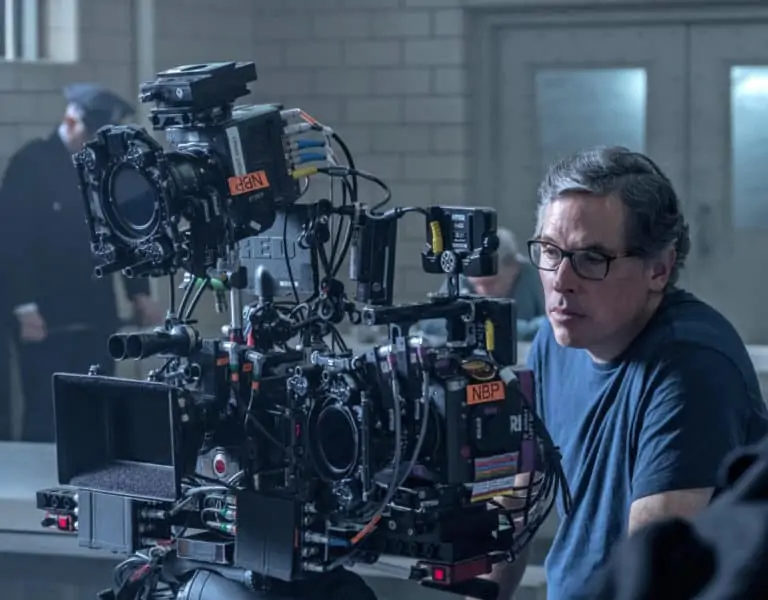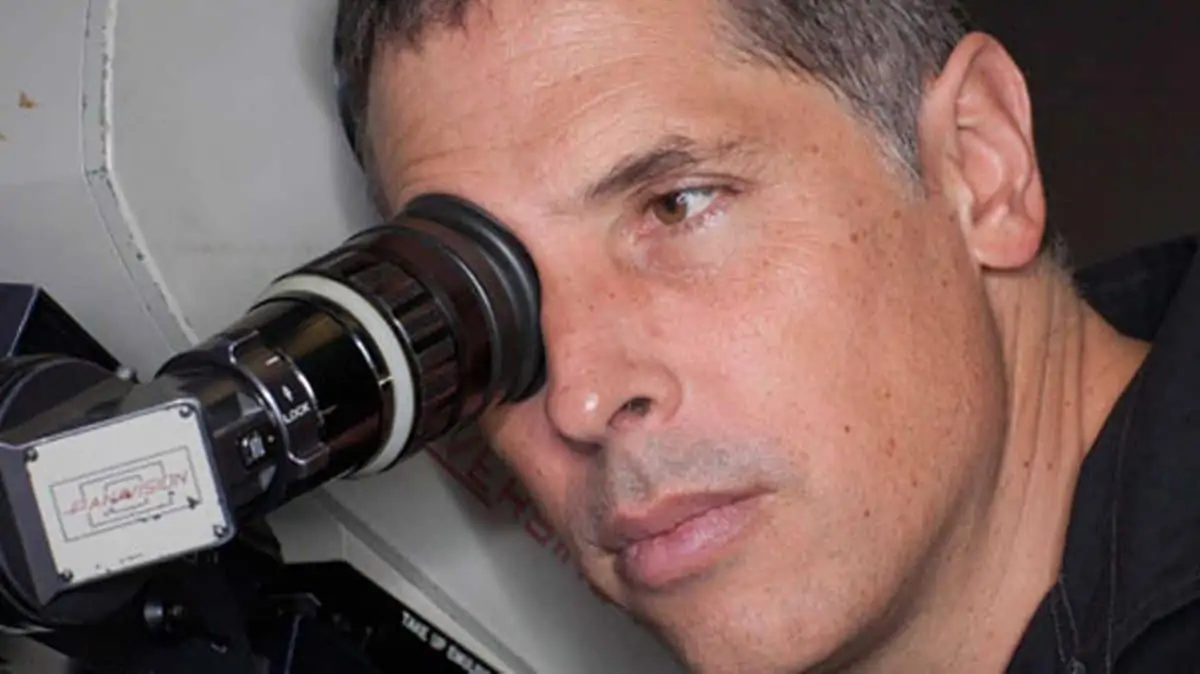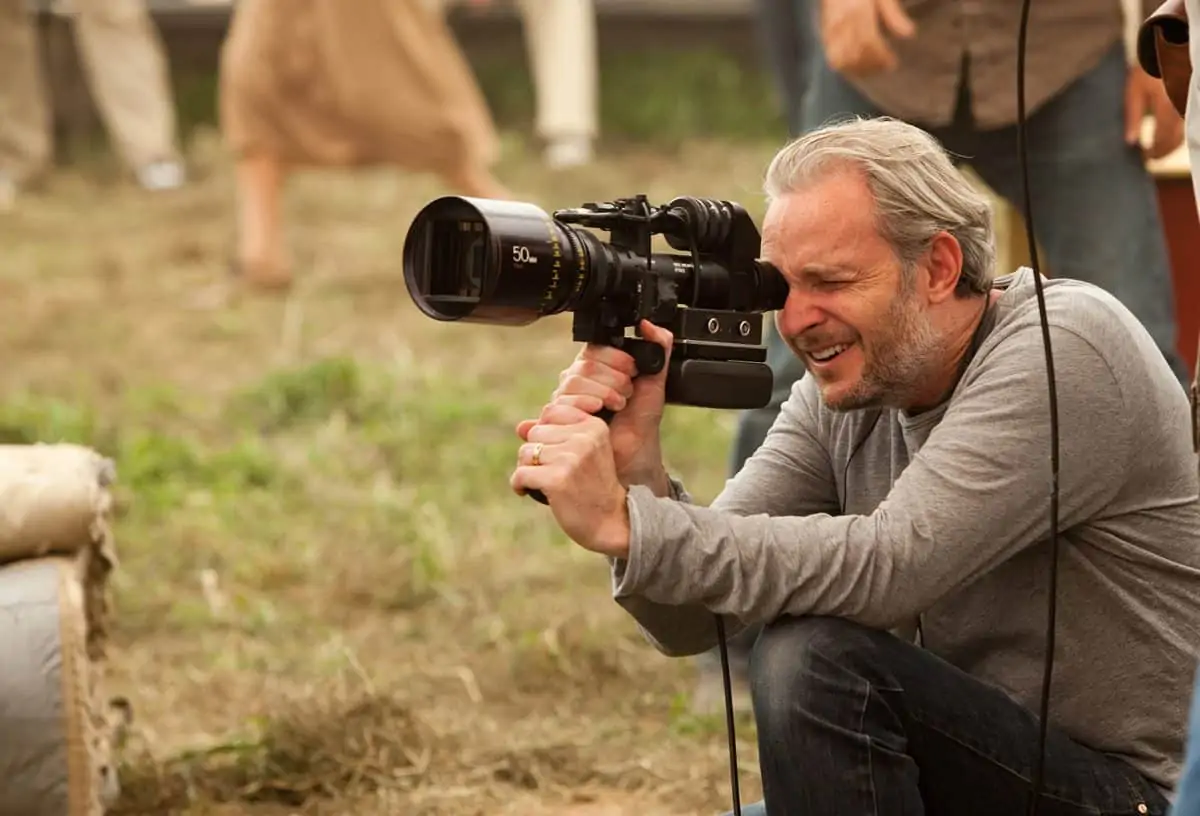IN SEARCH OF THE TRUTH
Yet another powerful meeting of creative minds between Martin Scorsese and Rodrigo Prieto ASC AMC sees the filmmakers breathe cinematic life into the true story of betrayal and murder that devastated the Osage community in 1920s Oklahoma.
A trail of death and deception lies at the centre of writer-director Martin Scorsese’s latest creation, western true-crime thriller Killers of the Flower Moon. Detailing white interlopers’ attempts to steal the wealth of the Osage people who became rich when oil was discovered on their land, the shocking tale is based on events that took place in 1920s Oklahoma when multiple members of the Native American Osage tribe were mysteriously murdered.
As well as being captivated by author and investigative journalist David Grann’s book upon which the film was based, Scorsese’s frequent collaborator, cinematographer Rodrigo Prieto ASC AMC, was angered by what he read: “Even before receiving the script, I knew it would be Scorsese’s next project, so I read the book and was fascinated by the story,” he says. “The scale of the evil, racism towards Native Americans and entitlement of the white settlers was shocking. I knew it was a very important story to tell.”
Similarly, when Scorsese first discovered the true story of crime, racism, and betrayal, he was eager to translate it into cinematic form. “I immediately started seeing it – the people, the setting, the action – and knew I had to make it into a movie,” he says.
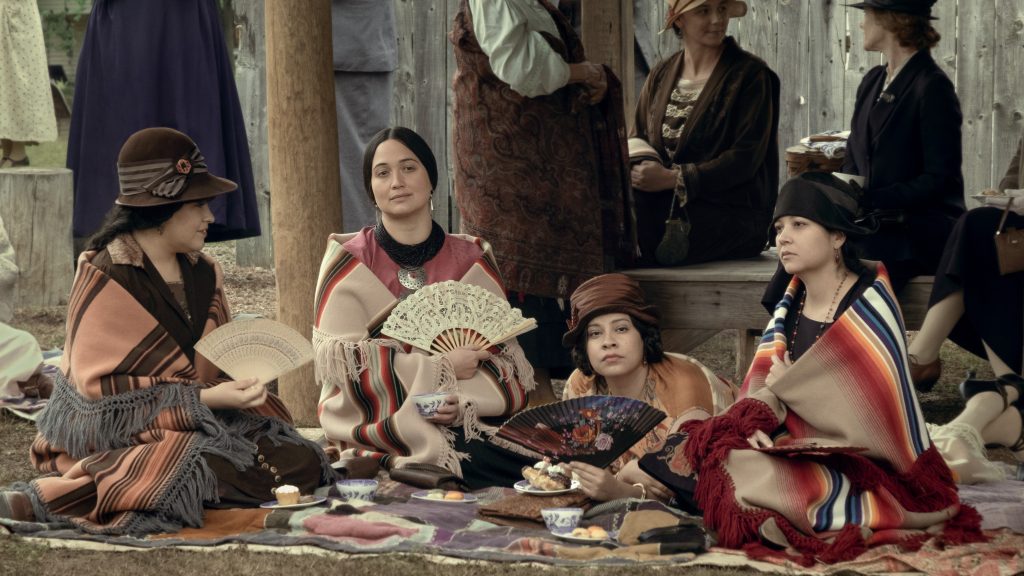
The film follows cattle rancher William Hale (played by Robert De Niro), who aims to win the oil rights of one Osage family by encouraging his nephew Ernest Burkhart (Leonardo DiCaprio) to marry tribe member Mollie Kyle (Lily Gladstone). As the mastermind behind a string of murders, Hale’s evil, bribery, and exploitation sparked the first major case to be investigated by the FBI.
In its original form, the script – penned by Scorsese and Eric Roth – was more closely based on the book, focusing on Texas Ranger and FBI detective Tom White (Jesse Plemons), and the investigation. After beginning prep in 2019, researching visual ideas and scouting around Fairfax in Oklahoma – where most of the action would play out – and Washington D.C. for scenes involving the FBI, the script was reworked. Flipping to a different perspective, the focus switched to Ernest, William, and Mollie, who had originally been peripheral characters.
“Ernest and William were just the bad guys in the first version, and it was about figuring out what they did. In the new script we knew what they did almost from the beginning, which is much more powerful,” says Prieto. “It was brilliant to maintain a movie that still has you riveted until the end even though it didn’t have the elements of a whodunnit. It was more about why they did it.”
Since teaming up on The Wolf of Wall Street (2013), Prieto has learned the importance Scorsese places on shot design. During pre-production, the director isolates himself to focus on shot listing which becomes Prieto’s production bible. “Marty creates diagrams of what the camera does and explains everything to me,” he says. “As this script was not completely locked when production began, he massaged it through pre-production and shooting, which was interesting because his design is normally very specific.”
The delicate subject demanded additional time and care be dedicated to determining how to portray characters. “Especially Ernest, who can be such a disgusting character. He’s weak, he kind of loves Mollie, but then he betrays her, and he’s our main character,” says Prieto. “Working out how to sustain a movie starring a person like that isn’t easy, so Scorsese tweaked that with Leo (DiCaprio). Even while shooting we experimented with different shades of Ernest and Mollie’s relationship and what was most effective and true to the story.”
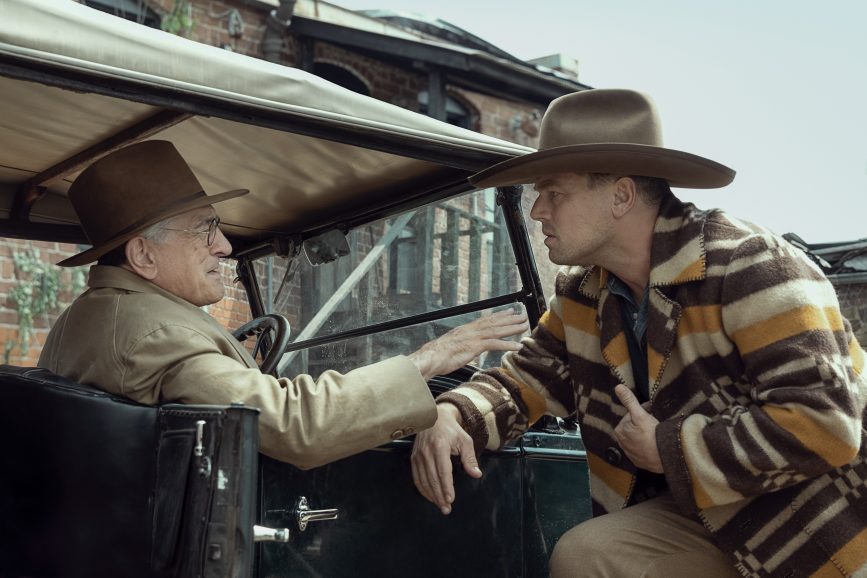
Authentic storytelling
With an ambition to shoot on location on the Osage reservation in Oklahoma where the events played out, Scorsese enlisted the full cooperation of the Osage Nation in the making of the film. In spring 2019, when Scorsese and his team travelled to the Osage reservation to scout and meet the Osage community, a strong bond was formed with Geoffrey Standing Bear, the Osage Nation’s Principal Chief. Scorsese maintained a connection with the Osage throughout each step of production, gaining a deep understanding of their history and culture.
Chief Standing Bear did not want the Osage to be shown “as just a bunch of bodies lying around” and felt it was essential for the history and culture to be accurately represented. “Mr Scorsese was so respectful in the way he and his people came to us,” Chief Standing Bear says. “He pointed out some of the movies he made, in particular Silence [also lensed by Prieto], in which the cultures of Christian missionaries and 17th-century Japan were presented in a serious and respectful manner, and that was encouraging.”
Prieto was heavily involved in location scouting, as on previous Scorsese films he lensed. Normally the production designer, as a first filter, does the initial scout and Prieto joins them on the second to examine technical and logistical aspects of shooting each location, having an understanding of Scorsese’s taste and way of shooting following multiple collaborations.
“Marty’s very specific in his shot listing which he shares with me, so I kind of become his eyes when I do that scout. The production designer and I then present locations to Marty and try to have at least two options for each place,” says Prieto. “On this occasion, Marty went on one scout before me to Fairfax, Oklahoma. The main street of Fairfax didn’t work for us visually as it’s very wide and with many destroyed buildings, so we shot that in nearby Pawhuska, closing the main street and building new facades.”

With the film heavily rooted in research and locations selected aligning with where events took place, production designer Jack Fisk (The Revenant, There Will Be Blood) repurposed some existing structures or built them from scratch to tell the story on Osage land. Collaborating for the first time, when Fisk and Scorsese first discussed the project the director said, “I hear people say you can open up a film, make it look big.”
And so began a dream project for Fisk who has a reputation for building sets outside, not on sound stages. With much of Fairfax either modernised or run down, some alternative solutions were required. Redevelopment plans were delayed for land off Main Street in Pawhuska – where the old freight station stood and which had recently been bought by the Osage Nation – so Fisk’s team could build a station, bringing in 1,200 feet of track and a real train.
After scouting Fairfax, Scorsese briefly considered shooting in 3D, believing it might help convey the feeling of the vast vistas. “Coming from Manhattan and living in New York all his life, being in these big open spaces can sometimes be overwhelming, so he was intrigued by how to capture the depth and scope of open landscapes that feel so huge,” says Prieto.
Although 3D was discarded early on, nature became central to creative discussions, especially from the Osage perspective, with sweeping landscapes helping build an authentic world. “The Osage way of life is intimately connected to nature, with a deep awareness of the relationship between the earth and the sky,” says Prieto. “We wanted to understand this and try to capture it visually. I wanted the Osage part of the film to feel naturalistic – except for a few spiritual or dream-like moments – and for the colour to be true to what we saw on location. For scenes with only Osage present, we used a LUT that reproduces colours like film negative printed on film. We called it Regular Film LUT.”
Breathtaking landscapes were contrasted with the darker side of the tale of death and deception. “We didn’t approach it with the notion of let’s make pretty pictures of pretty landscapes; it was more about how to photograph what it feels like to be there in Oklahoma and to find areas without elements of modern civilisation,” says Prieto.
Shooting houses in which key scenes play out was also driven by picking authentic locations. Mollie’s house was built on land deemed most practical and realistic for the story, near a river which Mollie prays to in one sequence. “Often the camera was tight up against a wall or corner in the houses, but that creates a special feeling for the actors. There’s something exciting about shooting within the limitations of a room where you can’t remove a wall,” says Prieto, who also enjoys shooting on sound stages, but felt filming in real locations was fundamental to Killers’ success.
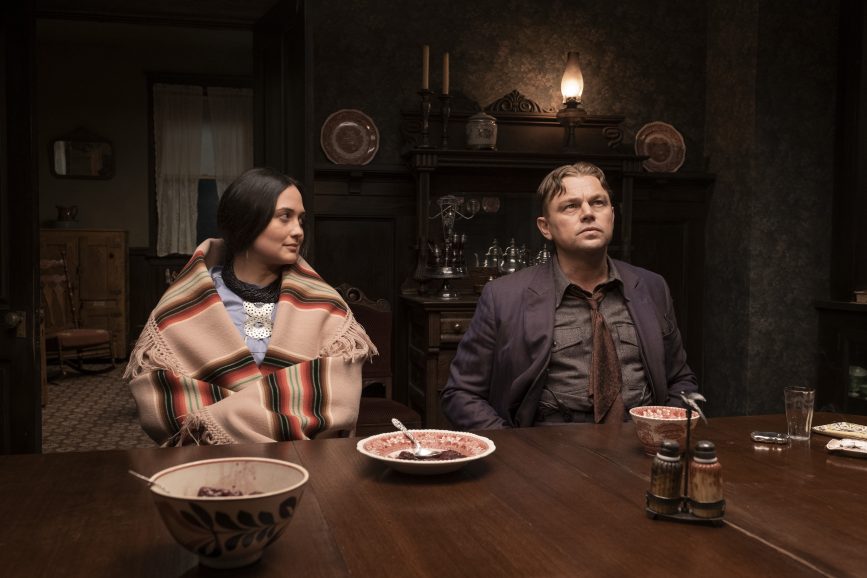
The dawn of colour
Having discovered how to allow the audience to feel the place in which the Osage people lived, the developments that took place and houses and cars they could buy once oil was found, the filmmakers explored the perspective and reactions of the white interlopers.
Prieto tried to differentiate it visually through first studying colour photography, a process he used for The Irishman. “I wanted to see what colour looked like in still photography of that time in the early ‘20s – the beginnings of colour photography,” says Prieto, who felt symbolising the descendants of European settlers’ view of the natural world could be achieved through a visual language in line with the technology and colour photography of the era.
His research began by examining the autochrome process invented in France by Auguste and Louis Lumière at the dawn of colour photography. He showed Scorsese books featuring autochrome photographs which the director liked but was concerned that some colours respond differently, so green or yellow are less bright and blue shifts more towards indigo. “He didn’t want the Osage costumes and blankets – which he was very taken by – to lose their vibrancy,” says Prieto.
Production designer Fisk and the art department’s creations were also driven by in-depth research, with every set and prop based on photographs of the era. Books on photochrom – the process for producing colorised images from a single black-and-white photographic negative – were also significant in the development of a LUT emulating autochrome and photochrom. The LUT was created by Prieto and his frequent collaborator Yvan Lucas, senior colourist at Company 3, using the same PPL software they developed for The Irishman with Philippe Panzini from Codex. Prieto considers Lucas a tremendously important member of the team, from pre-production through to the DI as they create LUTs together, Lucas supervises the dailies, and they then colour time the movie together.
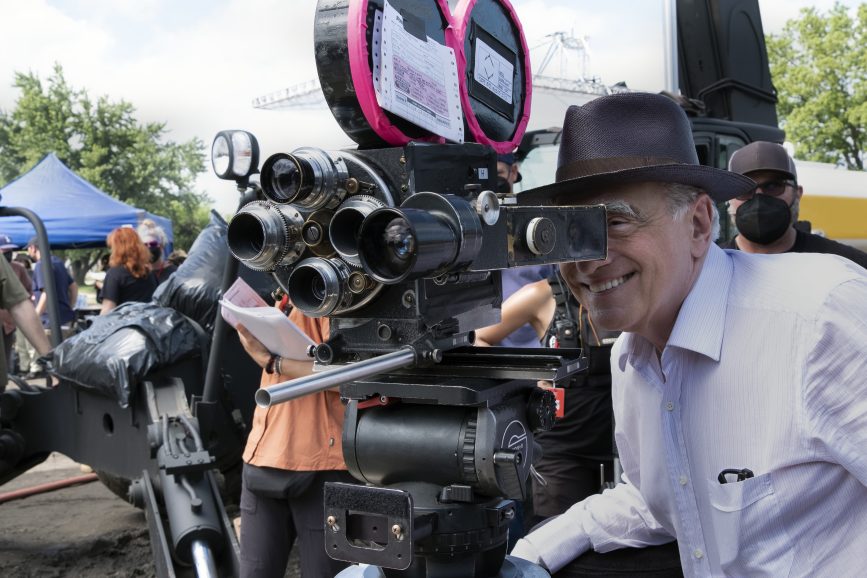
“Marty also referenced tint and toning – a photochemical process used at the beginning of colour photography to tint black-and-white print for film with colour,” says Prieto. “We didn’t do that to a great extent in the end, but it was an important part of the exploration.”
As Ernest’s situation becomes increasingly complicated, a more surreal visual approach was adopted. “We’re in his mind and he’s starting to go a little crazy, getting drunk, and becoming destructive, so we wanted to become more subjective,” says Prieto. “Some shots of him in the basement look red, inspired by the tint and toning we saw in reference books.”
Along with costume designer Jacqueline West, the filmmakers tested the way the colours of the Osage blankets and costumes would register with the Autochrome LUT. “Usually, the costumes would have been desaturated by the costume department so they wouldn’t pop too much. But in this case, we kept the original vibrant colours so the desaturation inherent in the Autochrome process would not make us lose their power,” says Prieto. “When shooting the costumes and working with the regular film LUT, we were careful to tone them down a little physically.”
A third look was crafted for a significant scene when a house is blown up and Ernest becomes aware of the extent of the destruction he is causing. “Things really turn dark, and Ernest’s conflict for what he is participating in becomes stronger and he becomes confused about where his loyalty lies,” says Prieto.
For this change in the narrative Prieto shifted to the ENR Technicolor process, working with a LUT he used on productions including The Irishman. “It’s a different type of colour desaturation that also enhances contrast and grain. The process was initially developed for Vittorio Storaro ASC AIC in Technicolor Rome and used for Reds (1981). You really feel the change when we switch to ENR – the look becomes bleaker and grittier.”
Based on colour history and what was used at the time, a LUT was built emulating three-strip Technicolor to make a sequence of a recording of a 1930s radio show more vibrant. Apart from stock archive shots of a plane, the few archive-style shots were captured by the crew using a 1917 Bell & Howell hand cranked camera owned by Scorsese. Captured on black-and-white negative, and mainly headed up by second unit director Ellen Kuras ASC, the sequences make use of the whole frame to the edges of the aperture.
Having sent the Bell & Howell to Panavision to be refurbished and cleaned, the crew endeavoured to understand how operators at the time worked with the camera, including setting the eye piece to the correct parallax. From reading the instruction manual, 1st AC Trevor Loomis even learnt a useful song to sing as he hand cranked to make the process easier.
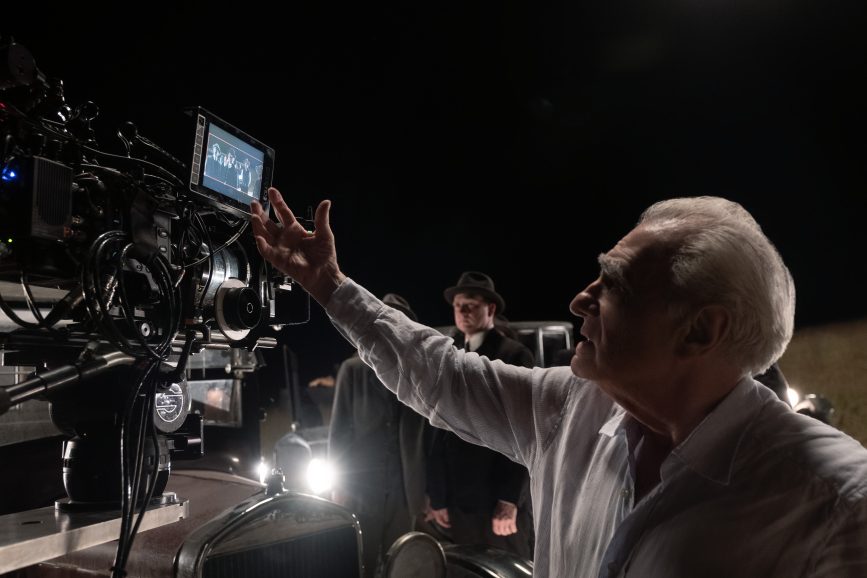
Taking stock
Representation and differing perspectives are core themes in Killers. In addition to the main characters’ viewpoints, especially Ernest and Mollie’s, an objective narrator perspective highlights the fact some of the murders are not witnessed.
“The camera’s just there, it’s an objective perspective of something secret that nobody’s witnessing. Thinking about how to represent that visually was crucial,” says Prieto. “Shots of the murdered Osage were usually overhead and followed a repetitive style of perspective and representation.”
In line with the representation theme, shooting mostly on celluloid was important to Prieto because it “has more of a feeling of the era and is a depiction of the times”. He felt capturing completely digitally would create a look that is too modern and less appropriate. “I believe film has more colour depth than digital, so being that we wanted to represent the Osage perspective of the story in natural colour, I felt the foliage and colours of nature are better captured by film negative.”
Killers was mostly captured on 35mm Kodak Vision3 500T 5219, a film stock Prieto has “always loved for shooting night, darker or tungsten-lit scenes”. Other sequences were shot on daylight balanced Vision3 250D 5207 or Vision3 200T 5213.
Testing saw the team create a small set featuring colours that would appear in the film, with production designer Fisk supplying panels in colours representing those that would be used on interiors and exteriors and stand ins representing key characters for skin tone and costume.
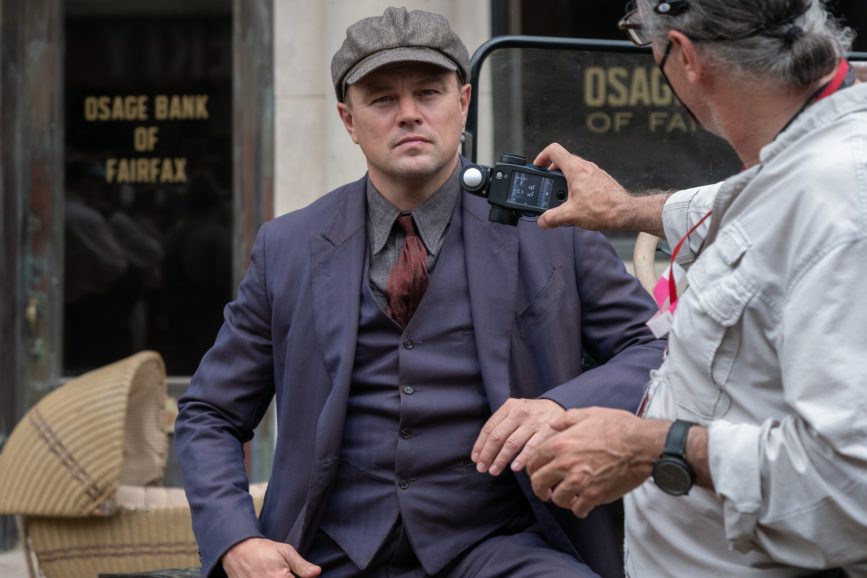
“Creating these little sets and lighting and shooting them identically with different camera formats and lenses is something I’ve done on many productions,” says Prieto. “I try not to influence the director and just see what feels right for the movie. In this case, we felt shooting on film with the Arricam captured the colours in the best way.”
When Prieto – a long-time user of ARRI cameras – was a young cinematographer growing up in Mexico, he mostly shot with the Arriflex. “I got used to the ARRI system and then moved a little towards Moviecam on films like 8 Mile (2002) and Amores Perros (2000) because the Moviecam SL was very lightweight,” he says. “And then ARRI came up with the Arricam – a combination of Arriflex and Moviecam which for me was the best of both worlds. Arricams are practical, relatively lightweight, and easy to thread, so it’s quick. I also like their eyepiece you can move to one side or the other and the high-definition video tap.”
However, when test footage of oil lamps was captured on film and digitally, Prieto discovered digital’s strength in low light. “I tested multiple digital cameras but found the Sony Venice helped me in many ways,” he says. “I could safely shoot at 2500 ISO and still have a very clean image in really low light levels. I also felt the colour level was closer to film than other formats.”
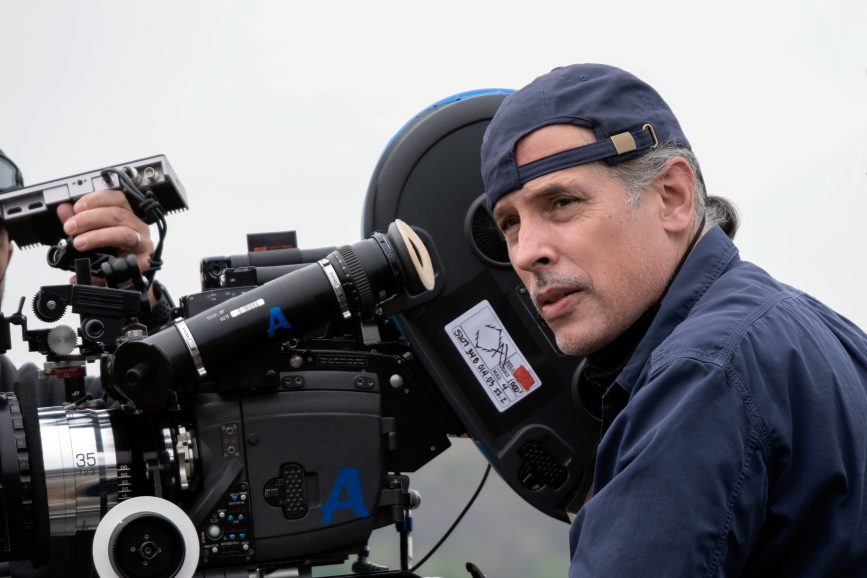
Rooted in realism
Enjoying “the best of both worlds”, Prieto switched to digital capture using the Venice for scenes in low light such as those set at dusk and several day for night sequences. Big night exteriors set in Fairfax also benefitted from shooting digitally. “In that era, they would have put up lightbulbs on poles and cable, called frayed lights. So, we lit big street scenes in this way, using construction cranes to hang truss structures supporting wires with hundreds of light bulbs on. Gaffer Ian Kincaid used 300-watt shatterproof bulbs coated in Teflon which was important as we didn’t want any wind to risk one falling and breaking on the actors,” says Prieto.
Kincaid and his team created rigs like those Prieto used on The Homesman (2014) which was shot in a windy area of Santa Fe, New Mexico. “If it’s windy, you make a big soft box with diffusion material and different types of bulb inside to create moonlight, which you can bring down safely if needed,” he explains. “On Killers we created different shapes of softboxes the wind could go through. Some Ian called chandeliers because the shape was created by a truss on top of a 20 by 20 foot frame connected to a smaller truss of 12 by 12. We could turn off one side if we didn’t want it to front light an area.”
A larger rig was created for a street celebration scene captured in Pawhuska. The rectangular frame was about 40 by 30 feet, with light bulbs hung over the street using a huge industrial crane. “Skirts around it prevented too much spill into the facades, creating soft, warm, ambient light we could quickly shoot in any direction. We shot it digitally because they’re simply light bulbs and don’t emit a lot of light.”
Prieto avoids using electrical lighting for day exteriors, finding it difficult to create a natural feeling, even through diffusion. He tries to manage day exteriors by ideally shooting in the correct direction at the correct time of day so he does not need to control it too much. “Sometimes you have to shoot all day, so you need to soften the sunlight,” he adds. “I like to use Half Soft Frost for that – a diffusion that doesn’t reduce the exposure much, it just softens the light. Or sometimes, when I’m filling a face from a daytime exterior, I’ll use day blue bounce – bleached muslin with a tiny bit of blue in it.”
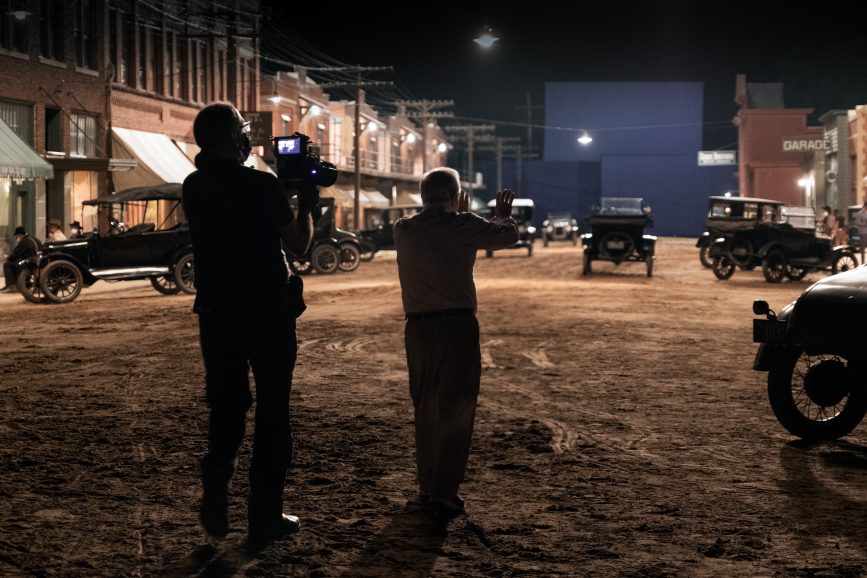
Lighting tools included tungsten fresnels, HMI pars and many styles of LED. For most daylight interiors the compact 18K K5600 Alpha fresnels were deployed through windows and doors coupled with 18K Arrimaxs when light was bounced or more intensity was needed. Interior lighting relied heavily on LiteGear LiteMat Spectrum LEDs and SkyPanel S360 and S60s. Astera Titan tubes were another integral part of the lighting arsenal and lantern light was usually enhanced by delicate placement of tiny 600-watt bare halogen bulbs, dimmed to an appropriate colour temperature.
When shooting a courthouse scene – in a church location production designer Fisk masterfully adapted – sufficient windows did not exist, so they were created. Prieto needed sunlight but the space between the fake windows and church wall was not deep enough. “I tested 18Ks, but the light spread to the sides, so we used High End Systems SolaFrame 3000 movers which are daylight balanced and can be panned and tilted remotely in the tight space to create shafts of light.”
Working with many existing locations presented some obstacles when trying to light spaces such as those in which an ambitious Steadicam shot takes place, moving through Mollie’s mother Lizzie’s house, focusing on different characters along its path. Gaffer Kincaid once again used fresnels through windows and sometimes diffused through Magic Cloth, so the windows were the light source. “On top of every window we put a strip of bright hybrid LED lights, developed by Ian, meaning you can still maintain the directionality of a window, but just out of frame on top of the window. That was also used to enhance the window light a little.”
Throughout the house, LiteGear LiteMats also produced soft, ambient top light. They became an integral part of the fixture line-up due to their light weight, compact size, and ability to create a soft source directly on a wall just out of frame or could be used for night scenes.
Realism was paramount and even in interior shots, when ceremonies are taking place, the sun was incorporated into the spaces. “The presence of the sun was essential in some scenes where we wanted the hot sun entering the room through a gap in the ceiling and for the bounce off a surface to light their faces,” says Prieto. “We used an Arrimax 18K aimed into a mirror rigged to the light at a 45-degree angle so the light could aim straight down through the small opening at the top of the native structure. No HMI of that size can be relied upon to continue functioning for days of filmmaking if it were aimed straight down without the stainless-steel mirror.”
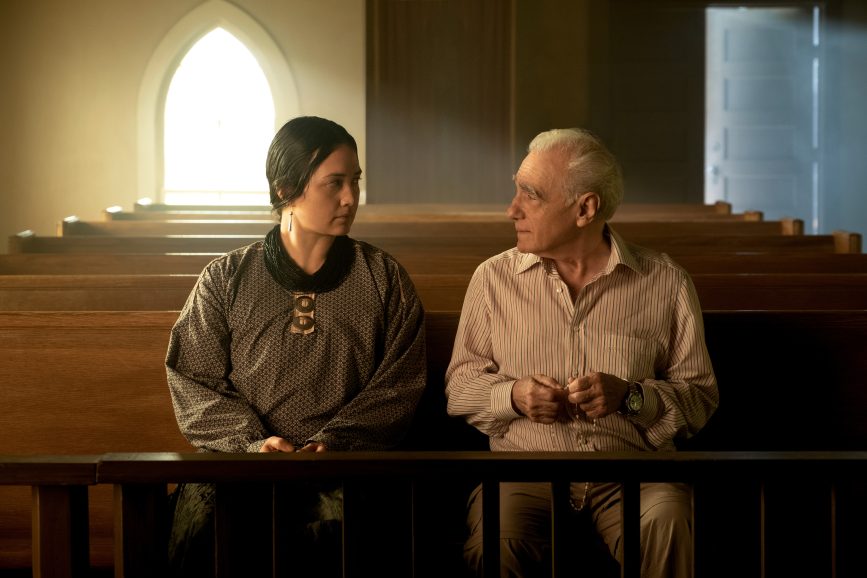
Thrilling filmmaking
In addition to Steadicam used for shots such as those moving seamlessly through key characters’ houses, Technocrane was chosen for select shots including some booming down in the courthouse. “Even though he’s done some of the most epic Steadicam shots out there, strangely enough, Scorsese is not really a fan of Steadicam as he doesn’t like imprecise camera,” says Prieto. “So, if he’s going to use Steadicam, it has to not feel Steadicam-like.”
Fortunately, Scott Sakamoto SOC, who Prieto considers “one of the best Steadicam operators out there” was on board to offer the “precision and elegance” Scorsese wanted. Prieto, who usually likes to operate when shooting on film, was so impressed by Sakamoto’s work that he asked him to take on the role of A camera operator.
Precision was also imperative when capturing scene-setting aerial sequences. “The shot of Ernest and Henry Roan driving down a road acts as the reveal of the oil rigs, captured by drone. Picking the location was important as we wanted the camera to track with the vehicle and then open up to reveal the place,” says Prieto.
“It needed to be captured precisely as the camera was circling around the car, with Scorsese and I supervising the shot. Scorsese is very specific about when the camera moves, and when it doesn’t, and he wanted another shot of the aftermath of a house explosion to be static wide shot. That can sometimes be tough using a drone because any wind can cause movement, but it was captured perfectly.”

Having decided early on with Scorsese that widescreen 2.35 was the most appropriate aspect ratio due to the landscapes being captured in the air and on land, extensive testing saw Prieto compare spherical and anamorphic lenses. With everything pointing to horizontal framing being preferable, the filmmakers crowned Panavision’s anamorphic T Series their lens of choice for the production. “It was ideal, especially when Dan Sasaki at Panavision adapted them to feel a little more vintage, and so they had a subtle distortion on the edges,” says Prieto. “The flare was a bit warmer as even if there’s a window or an oil lamp, I feel a blue flare feels modern.”
Some sequences were shot with vintage Petzval lenses from the 1920s to distort the edges. But at first Prieto and Scorsese were unsure what they would use them for when testing a set adapted by Sasaki. “Marty then suggested they could be appropriate for lensing the bodies of the murdered Osage, since the shots are sort of disconnected from the story and as if the camera has stumbled upon them,” says Prieto. “He felt a specific feel and vignette could be produced using the distortion on the edges of the Petzvals, removing the audience from the situation a little through a strange perspective on the bodies.
“But sometimes Marty used the Petzval for other types of shot. That’s something I love about him – he creates these rules, but then he breaks them, and gives himself that freedom. He plans everything very carefully, but then listens to his gut feeling in the moment and that’s one of the things that makes him such an exciting filmmaker to work with when telling powerful stories such as this.”
